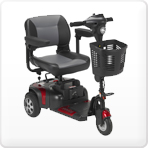Knowing the Importance of Proof of Delivery Requirements
Along with products and services to help suppliers thrive, Drive now offers information and a variety of services on Medicare reimbursement and compliance issues through The MOBILITY Consultants, LLC. These added value services can help answer the questions so many suppliers have about the mobility business, increase first time approvals and assist with all audits for Medicare claims.Along with products and services to help suppliers thrive, Drive now offers information and a variety of services on Medicare reimbursement and compliance issues through The MOBILITY Consultants, LLC. These added value services can help answer the questions so many suppliers have about the mobility business, increase first time approvals and assist with all audits for Medicare claims.
The MOBILITY Consultants is in the business of providing a comprehensive resource for mobility reimbursement and regulatory compliance issues. For more information on The MOBILITY Consultants and a menu of services we offer, visit our website at The MOBILITY Consultants.

Proof of delivery is required by Medicare in order to verify that the beneficiary received the DMEPOS and is one of the provider standards as noted in 42 CFR, 424.57(12). Proof of delivery documentation must be made available to the DME MAC upon request. For any services, which do not have proof of delivery from the provider, such claimed items and services shall be denied and overpayments recovered.
Providers are required to maintain proof of delivery documentation in their files for seven years.
Delivery Methods
Note: For the purpose of the delivery methods noted below, the designee is defined by Medicare as:
“Any person who can sign and accept the delivery of durable medical equipment on behalf of the beneficiary.”
Providers, their employees, or anyone else having a financial interest in the delivery of the item are prohibited from signing and accepting an item on behalf of a beneficiary (i.e., acting as a designee on behalf of the beneficiary). The relationship of the designee to the beneficiary should be noted on the delivery slip obtained by the provider (i.e., spouse, neighbor, etc.). The signature of the designee should be legible. If the signature of the designee is not legible, the provider/shipping service should note the name of the designee on the delivery slip.
Method 1—Direct Delivery to the Beneficiary By the Provider
Providers may deliver directly to the beneficiary or the designee. An example of proof of delivery to a beneficiary would be having a signed delivery slip. The proof of delivery record must include:
*Beneficiary’s name
*Delivery Address
*Providers are to use the address for the location where the items were delivered. If delivered to a facility, the delivery address would be the facility address
*Quantity delivered
*Sufficiently detailed description of the item(s) being delivered (e.g., brand name, serial number, narrative description)
*Date delivered
*Beneficiary (or designee) signature and date of signature
The date of signature on the delivery slip must be the date that the DMEPOS item was received by the beneficiary or designee. In instances where the DMEPOS item are delivered directly by the provider, the date the beneficiary received the DMEPOS item shall be the date of service on the claim.
Method 2—Delivery via Shipping or Delivery Service
If the provider utilizes a shipping service or mail order, the proof of delivery documentation must be a complete record tracking the item(s) from the DMEPOS provider to the beneficiary. An example of acceptable proof of delivery would include both the provider’s own detailed shipping invoice and the delivery service’s tracking information. The provider’s record must be linked to the delivery service record by some clear method like the delivery service’s package identification number or provider’s invoice number for the package sent to the beneficiary. The proof of delivery record must include:
*Beneficiary’s name
*Delivery address
*Delivery service’s package identification number, provider invoice or alternative method that links the provider’s delivery documents with the delivery service’s records.
*Sufficiently detailed description to identify the item(s) being delivered (e.g., brand name, serial number, narrative description)
*Quantity delivered
*Date delivered
*Evidence of delivery
If a provider utilizes a shipping service or mail order, providers shall use the shipping date as the date of service on the claim.
Providers may also utilize a return postage-paid delivery invoice from the beneficiary or designee as a form of proof of delivery. This type of proof of delivery record must contain the information specified above.
Method 3—Delivery to Nursing Facility on Behalf of a Beneficiary
When a provider delivers items to a nursing facility, the documentation described for Method 1 is required. When a delivery service is used to deliver the item to a nursing facility, the documentation described for Method 2 is required. Regardless the method of delivery, for those beneficiaries that are residents of a nursing facility, information from the nursing facility showing that the item(s) delivered for the beneficiary’s use were actually provided to and used by the beneficiary must be available upon request.
Items Provided in Anticipation of Discharge from a Hospital or Skilled Nursing Facility
Exceptions to the preceding statements concerning the date(s) of service on the claim occur when the items are provided in anticipation of discharge from a hospital or nursing facility. A provider may deliver a DMEPOS item to a patient in a hospital or nursing facility for the purpose of fitting or training the patient in the proper use of the item. This may be done up to two days prior to the patient’s anticipated discharge to their home. The provider shall bill the date of service on the claim as the date of discharge and shall use the POS code 12 (patient’s home). The item must be for subsequent use in the patient’s home. No billing may be made for the item on those days the patient was receiving training or fitting in the hospital or nursing facility.
A provider may deliver a DMEPOS item to a patient’s home in anticipation of a discharge from a hospital or nursing facility. The provider may arrange for actual delivery of the item approximately two days prior to the patient’s anticipated discharge to their home. The provider shall bill the date of service on the claim as the date of discharge and should use the POS code 12 (patient’s home).
Having the appropriate proof of delivery documentation to support the date of service on the claim is necessary and will alleviate any potential proof of delivery issues in the future.



